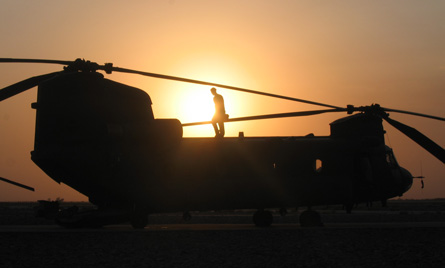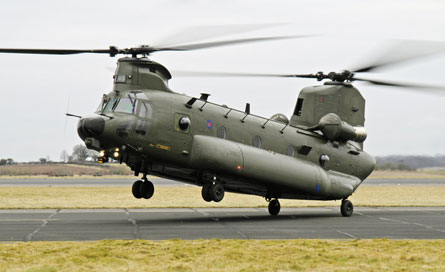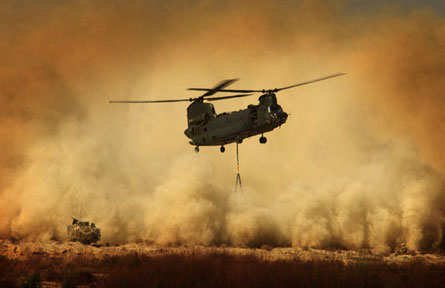Almost two years after its Boeing Chinook HC2/2A transport helicopters began operating in Afghanistan's Helmand province, the Royal Air Force is delivering more flying hours with the type than ever.
Achieved in part due to a new engineering infrastructure that is also delivering improved training services in the UK, the advance is the centrepiece of a plan that will see annual utilisation rates rise by more than a third by next year.
Eleven of the RAF's Chinooks are deployed on operations, with 10 flying in Afghanistan (pictured below) and one in Iraq. A further 15 are assigned to its 7, 18 and 27 squadrons at Odiham, Hampshire, with the remainder involved in maintenance and upgrade activities.
The service early this decade launched a project to boost the operational efficiency of the fleet, with support enhancements sought to increase availability and reduce the amount of scheduled maintenance time for aircraft.
 |
|---|
© Sqn Ldr Paul Kelly/Crown Copyright |
"When we started this process the maximum the Chinook force had ever delivered was about 12,000h [per year]," says Gp Capt Andy Turner, station commander at RAF Odiham. "We are today on a sure path to deliver 16,000h by next year, and potentially greater than 18,000h from 2010."
One element of the reform has been delivered through improvements in the provision of so-called "depth" maintenance at the now Vector Aerospace-run Fleetlands site in Hampshire. Boeing was in May 2006 awarded a 34-year through-life customer support contract that required an annual 12,500 flight hours from a frontline fleet of 27 aircraft.
"They have turned themselves inside out, and we have really seen the direct benefits of incentivisation," says Turner, who adds: "Without their effort we wouldn't be able to deliver the 16,000h." Boeing also has on-site representatives at Odiham under the TLCS deal, which has already contributed to an increase in utilisation to 13,500h.
But the RAF has not relied solely on the efforts of industry to transform its Chinook operations, having also taken the difficult decision to dismantle and reform its own maintenance activities as part of the process.
Support to 18 and 27 squadrons was historically provided by the units' own engineering personnel, but these have now been amalgamated into a single unit of around 300 people, including three maintenance flights of 70 staff each.
"We have been through a lot of pain to lose the squadron identity, but we've created a new one and we're working really well," says Sqn Ldr Paul Kelly, the outgoing officer commanding of the Odiham-based Expeditionary Chinook Engineering Squadron (ExCES).
Creating a combined engineering unit has removed duplication in trades, and freed resources for more "spanner turners" at a time of high operational tempo, he adds.
 |
|---|
© Crown Copyright |
The ExCES unit also last year established a pulse line at Odiham to conduct primary and primary star maintenance work on the Chinook at 150h intervals, with minor and major services performed at Fleetlands after every 600 and 2,400 flight hours, respectively. Two aircraft are on the pulse line at any one time, with each receiving 1,200 man hours of work.
"In order to deliver the additional hours, we need to generate an aircraft out of there with 150h clear every 13 days," says Kelly, with this to be reduced to 11 days in order to meet the 16,000h objective.
"When the aircraft arrives we are ready to run," he says, adding: "Morale is sky high among the guys - they are delivering."
Pulse line operations started last year in June, and between August and March this year only three aircraft were completed late.
Further improvements to pre-arrival planning, lean initiatives and the choreography of the line are now being investigated, along with a possible increase in manpower to move towards the goal of 18,000 flight hours.
The RAF and Boeing are also looking at the possibility of extending some service intervals.
Part of the resultant increase in flying operations will in addition be achieved by expanding the Chinook fleet through the availability of eight currently stored, longer-range HC3 airframes (pictured below) that are to undergo a "fix-to-field" programme worth more than £60 million ($119 million), including funds for more air crew and support personnel.
 |
|---|
© Qinetiq |
"I see the aeroplanes being absorbed into the whole fleet so that they will be almost seamless," says Turner. "They will be slightly different visually, but they will be operated by everybody." The modified HC3s will arrive at Odiham in ones and twos from mid-2009, with all the necessary equipment for deployment to Afghanistan from late the same year, or during 2010, he adds.
Another vital element of the current engineering transformation process has been the creation of a combined flying programme, which Kelly describes as a contract between the engineering wing and squadron aircrews.
Typically, seven aircraft are on the flightline at Odiham each day: four to support squadron training requirements, plus two spares and one held at readiness to support national emergency commitments if required.
The new system has at times proved contentious, but Kelly says: "If you have tasking lines and spares you achieve much more than: 'let's fly everything that's serviceable'. The spares are available to make sure that those sorties happen."
The benefit, he adds, comes when the spares are not required. "Then I'm engineering for tomorrow's flying programme and we're on the front foot, not trying to recover aircraft for the second wave. We've ceased to be a reactive organisation and have become proactive."
Other initiatives, such as changing crews with the rotors still turning, have also contributed to the success of the new model, according to Kelly, and only two sorties totalling around 4h were lost during February due to line aircraft and spares both being unserviceable.
"Essentially, we achieved 99.5% of the task asked of us," he says. "Availability and serviceability are dead statistics in this construct: flying hours achieved is the statistic that's worth looking at."
Aircraft tasking is also now the responsibility of an engineering programme manager, with the non-commissioned officer "maintaining the beat of the squadron" by assigning Chinooks to the flying programme, while overseeing those that are due for the pulse line or heavy rectification work. The manager also liaises with the depth organisation on long-term fleet management issues.
 |
|---|
© Crown Copyright |
Turner expects Odiham's squadrons to sustain operations in Afghanistan for the next five years "and maybe substantially longer". He notes: "We bought the aircraft in 1981, they were deployed in 1982 and they haven't come home since. The Chinook force is well configured, both for air crew and support staff to endure."
Noting that the recent improvement in utilisation rates has been achieved under a climate of reduced resources, Turner concludes: "This hasn't been about investment to get more. This is about Helmand, and the people who are clearing trenches by night. It's about getting them on and off the ground quickly. That's why we are working so hard."
Source: Flight International
















